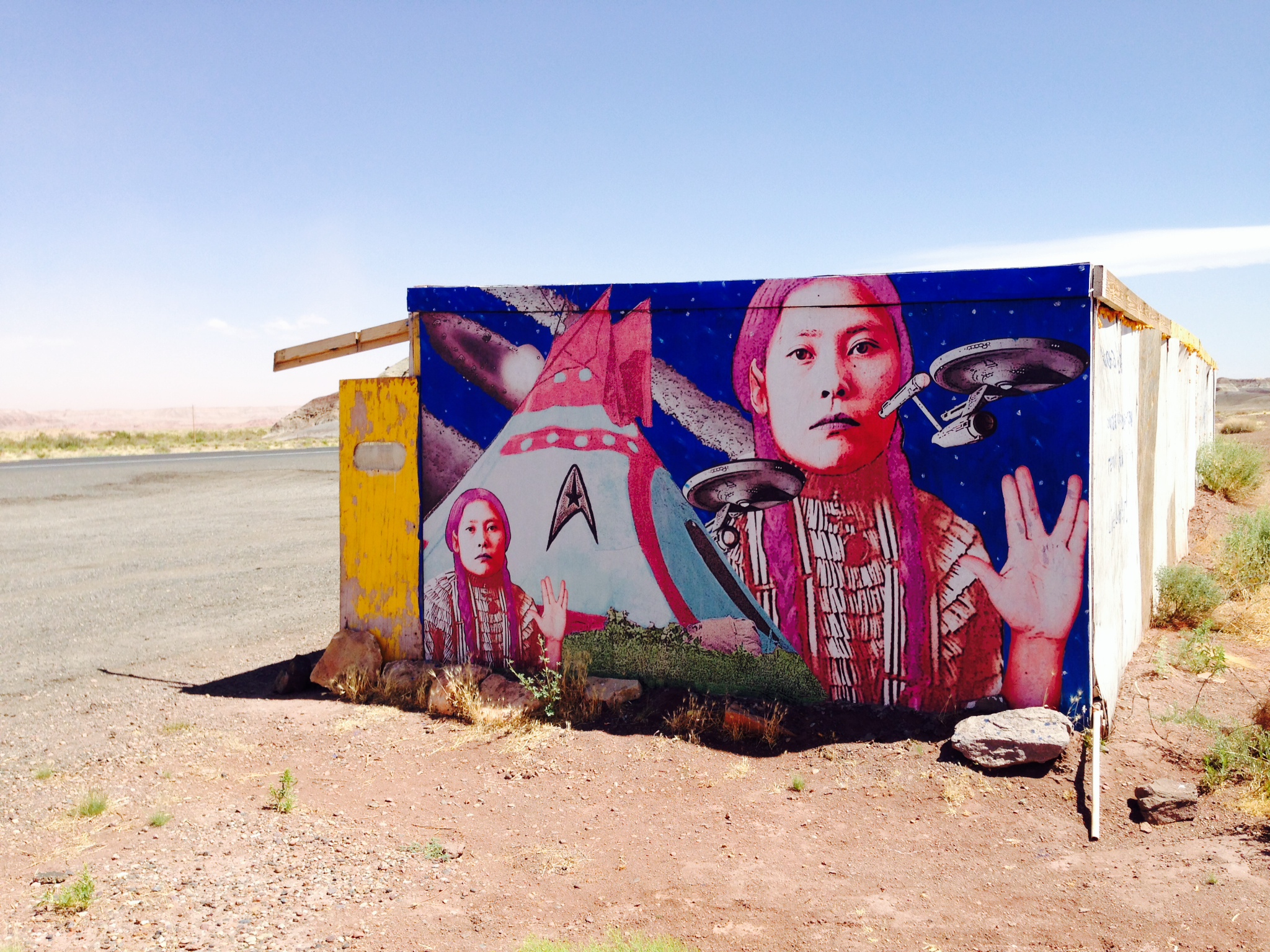Welcome Back From Where-Ever Your Summer Journeys Took You
/
The above image was shared with me by a reader, Robert Spadoni, who spotted this mural outside Gap, Arizona, while driving with his family across the American west. Robert shared the following story:
We hadn't seen a business or residence for a couple of hours at least, and hardly any cars. We pulled over to change drivers, and for no reason, just to be goofy, I pulled way in to the edge of this gigantic deserted turnout on the side of the road, right up to this empty structure. I'm a huge fan of the Original Series of Star Trek, and my 12 year old exclaimed, "The Star Trek symbol!" I was getting ready to say something like, "Yeah, It DOES kinda look like that," when I looked up. Apparently, from my searches, this mural is below the radar even of Google—I didn't think there was anything left that was.
Robert asked me to share a few thoughts. For me, this is a great example of the ways that each of us construct our own personal mythology from the culture around us, increasingly mixing and matching elements that have very distinctive histories and meanings. I suppose you could call this "postmodern," since it reflects the breaking down of traditional kinds of fixed social identities and coherent cultural narratives, in favor of a process of continuous self-fashioning and ongoing appropriation and remixing. The result can be surprising juxtapositions of images and meanings. And on one level, what we see here -- without knowing anything beyond what Robert shares -- can seem idiosyncratic, highly personal, perhaps undecipherable to someone not on the same wave length with the artist. Someone like Frederic Jameson might talk about this in terms of the flattening of affect and the implosion of meaning, but I don't think either is what is going on here -- certainly not for the original artist and not to Robert, his family, or myself. We recognize the icons being deployed here; we understand some possible meanings for them, and if anything, there is too much meaning here for us to put easily into words.
At a most basic level, the image bridges between "Space, the final frontier" and the kinds of frontier imagery we associate with the American west. Yet, what is striking to me is the way that the Star Trek images are mapped not onto the rootless cowboy moving endlessly across the western badlands, but rather onto images associated with native Americans. Just as we've seen the emergence of Afro-Futurism which uses the juxtaposition of science fiction imagery with historic experiences of race, we have seen First Nation people all over the planet embrace images from science fiction as a means of inserting themselves into our imaginings of the future, as a way of signaling that their culture may be traditional but that it is not stuck in the past, that they will carry their traditions with them into the future. I have no way of knowing here whether the artist is native American or appropriating native American images for his or her own purposes, opening up some tensions around what we see as appropriate or inappropriate forms of appropriation. Even in an era of remix culture, as we discuss in my Reading in a Participatory Culture book, there are power relations such that the appropriation of minority identities and expressions by dominant groups have different political meanings than the appropriation of majority cultures by minority communities. (We might think about this image in relation to the character of Chakotay in Star Trek: Voyager, a character who was variously read in terms of expanding representations within a multicultural narrative or in terms of the exploitation of stereotypes about tribal communities in ways that did not necessarily speak to how First Nation peoples understand themselves and their own cultural experiences.)
And part of what I find compelling about Robert's image and story is that we don't have any answers about who the author is, what motivated them to produce this mural, and in what ways they are seeking to make meaning of the relationship between Star Trek and Native American cultural traditions.
I am sharing this image (and my speculations about it) today as a signal that the blog is back up after my typical summer hiatus. I've had a very productive summer, which has included so far, the completion of my next book, By Any Media Necessary: Mapping Youth and Participatory Politics, which we sent off to be peer reviewed a few weeks ago and which we hope will come out in the not-too-distant future. I've also made significant progress on several other fronts, including a new essay on the current state of fandom studies, which will be published in the Journal of Fandom Studies; an essay on the history of aesthetic experimentation that has surrounded Daredevil in the Marvel universe; a collaborative essay on the many different political uses that have been made of the Superhero in recent years; and some early work on a new project -- a series of critical essays on 9 different contemporary graphic novelists. So, I may not be coming back from the break rested, but I do come back with a strong sense of accomplishment and a determination to hit the deck running as we move into the new academic year.
We have a great line-up of interviews for the coming term, which I will start sharing in just a few days.


